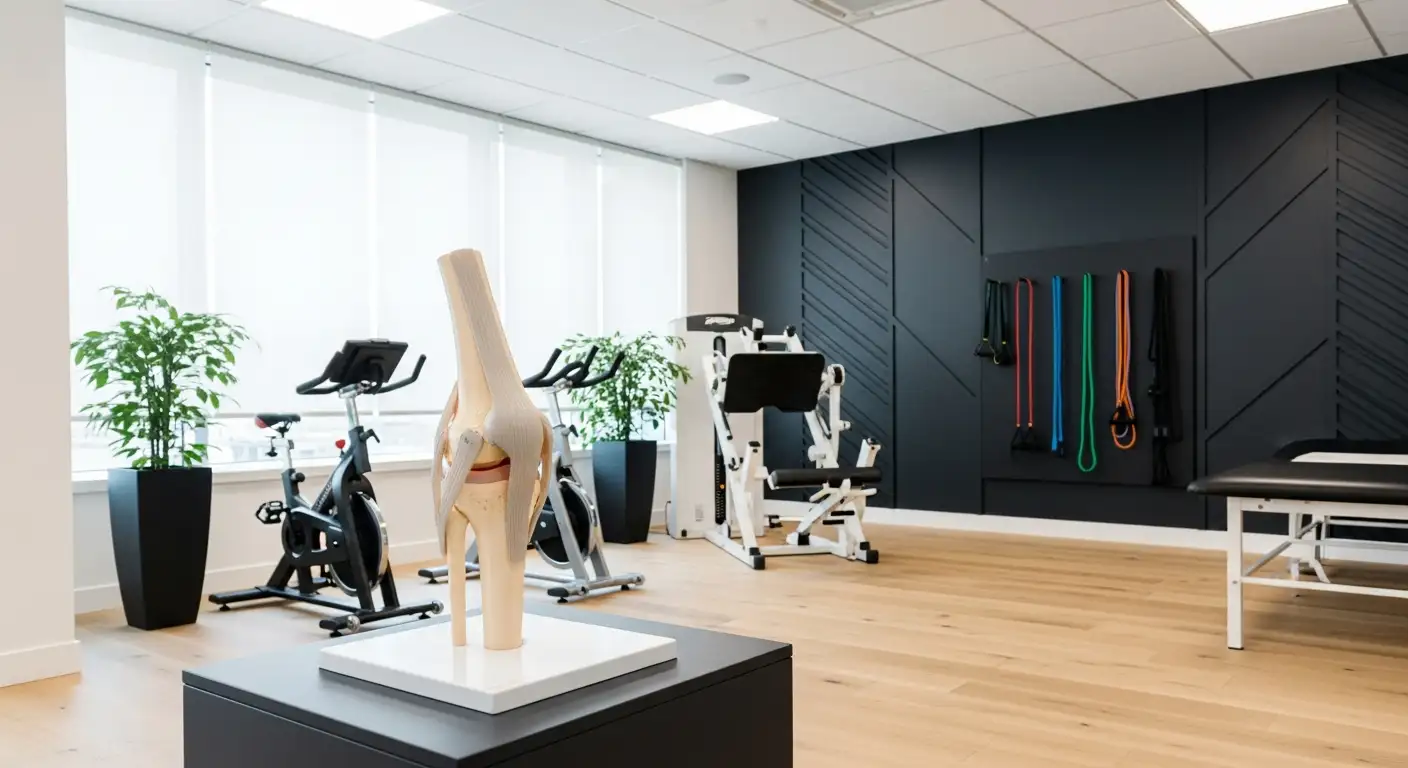Understanding Inside Knee Pain
Inner knee pain, often referred to as knee pain on the inside of the knee, can be a significant discomfort that hinders daily activities. This pain can stem from various conditions, each with its own set of symptoms and treatment options.
Common Causes of Inside Knee Pain
Several conditions could lead to knee pain on the inside of the knee, including but not limited to:
- Bursitis: This condition is characterized by the inflammation of one or more of the bursae, small fluid-filled sacs near the joints that reduce friction and cushion pressure points.
- Osteoarthritis: A degenerative joint disease that can lead to pain and stiffness in the knee [1].
- Meniscus Tear: An injury to the cartilage cushion between the shinbone and thighbone can also cause inside knee pain [1].
- Tendon Injury: In certain cases, knee pain on the inside of the knee may occur due to injury or strain on the tendons.
- Medial Collateral Ligament (MCL) Injury: This is a common cause of inside knee pain, typically occurring when impact happens on the outside of the knee, overstretching or tearing the inside ligament [2].
- Alignment Issues: Conditions like knock knees or flat feet can affect the distribution of weight and pressure on the joint, contributing to inner knee pain [1].
Symptoms and Diagnosis
Symptoms of inside knee pain include swelling, warmth to the touch, redness, instability or weakness, popping or grinding sensations, and stiffness. If you experience any of these symptoms, it's vital to seek medical advice for an accurate diagnosis.

Diagnosis of the cause of inner knee pain typically involves a physical examination and imaging tests such as X-rays or MRIs. In certain cases, arthroscopy may be used for a more detailed view inside the knee joint.
Understanding the cause of knee pain on the inside of the knee is the first step towards finding an effective treatment plan. In the following sections, we will delve deeper into the causes, risk factors, and treatment options for inside knee pain.
In-depth Look at Causes
There are several root causes of knee pain on the inside of the knee, also known as medial knee pain. Understanding these causes can help in finding effective solutions for managing and mitigating the discomfort. Here, we delve into four common causes: bursitis, osteoarthritis, tendon injury, and meniscus tear.
Bursitis and Inside Knee Pain
Bursitis refers to the inflammation of one or more bursae, the small fluid-filled sacs near the joints that reduce friction and cushion pressure points. When the bursae in the knee become inflamed, it can lead to knee pain on the inside of the knee. Bursitis can be caused by overuse, injury, or an existing inflammatory condition. Treatment typically involves rest, ice, and over-the-counter anti-inflammatory medications.
Osteoarthritis and Inside Knee Pain
Osteoarthritis is a degenerative joint disease that can contribute to knee pain on the inside of the knee. This condition involves the wearing down of the cartilage that cushions the ends of the bones in your joints, leading to stiffness and pain. Osteoarthritis of the knee can affect any part of the joint, but pain on the inside of the knee is common.
Tendon Injury and Inside Knee Pain
Tendons are strong bands of tissue that connect muscles to bones. Overuse or strain can lead to tendon injuries, which in turn can cause knee pain on the inside of the knee. This pain is often felt when moving the knee or engaging in activities such as running, skiing, or cycling.
Meniscus Tear and Inside Knee Pain
The meniscus is a piece of cartilage that provides a cushion between your shinbone and thighbone. A meniscus tear can cause knee pain on the inside of the knee. This type of injury often occurs during sports when the knee is twisted while the foot is planted on the ground.
Each of these conditions requires different treatment approaches for optimal recovery. These can include strengthening exercises, physical therapy, rest, ice, compression, and elevation (RICE protocol), and over-the-counter pain medications. In severe cases, surgery may be considered.
Risk Factors for Inside Knee Pain
Understanding the risk factors for knee pain on the inside of the knee can be instrumental in preventing its occurrence and managing its progression. Among the primary risk factors are age, overuse, and obesity.
Age and Inside Knee Pain
Age is a significant risk factor for inside knee pain. Knee osteoarthritis, a common cause of knee pain, typically results from wear and tear and progressive loss of articular cartilage. It's most prevalent in the elderly, with the prevalence of knee osteoarthritis rising to as high as 40% in individuals older than 70 years of age. It's worth noting that the prevalence is lower in males than females, and only 15% of patients with radiographic findings of knee osteoarthritis are symptomatic. While knee osteoarthritis is generally a progressive disease that may eventually lead to disability, understanding the risk associated with age can help in taking preventive measures.
Overuse and Inside Knee Pain
Overuse is another common risk factor for inside knee pain. Overuse-related knee pain can result from physical activities, sports, or repetitive motions that exert constant pressure on the knee joint. This consistent strain can lead to conditions like arthritis, causing pain, swelling, and stiffness in the knee joint. Furthermore, injuries such as ligament tears or fractures, often resulting from overuse, can also lead to knee pain. Recognizing the role of overuse can guide individuals in moderating their physical activities to prevent or manage knee pain.
Obesity and Inside Knee Pain
Obesity is a significant risk factor for knee pain on the inside of the knee. Excessive body weight puts additional pressure on weight-bearing joints like the knee, exacerbating wear and tear, and increasing the risk of conditions like osteoarthritis. This connection between obesity and knee pain underscores the importance of maintaining a healthy body weight as a preventive measure [7].
It's important for those experiencing knee pain on the inside of the knee to consider these risk factors. By understanding the role of age, overuse, and obesity in causing knee pain, individuals can take targeted steps to manage their risk and alleviate their symptoms.
Treating Inside Knee Pain
Treating knee pain on the inside of the knee can be approached with different methods, depending on the severity and root cause of the pain. Two common routes for treatment include conservative treatments and surgical interventions.
Conservative Treatments
Conservative treatments involve non-surgical methods aimed at alleviating the pain and inflammation, and typically serve as the first line of treatment. These methods can be effective in managing pain and are often recommended before considering surgical options.
Common conservative treatments include:
- Patient Education: Understanding the cause of the pain can help the individual manage their symptoms and avoid movements or activities that exacerbate the pain.
- Physical Therapy: A physical therapist can guide the patient through specific exercises designed to strengthen the muscles around the knee, improving stability and reducing pain [4].
- Weight Loss: For those who are overweight, losing weight can help reduce the stress on the knee joint, which may alleviate pain.
- Drug Therapy: Over-the-counter pain medications, such as NSAIDs or acetaminophen, can help manage the pain and inflammation.
- Rest, Ice, Compression, and Elevation (RICE protocol): This method helps reduce inflammation and swelling, aiding in the healing process.
- Knee Braces: These provide support to the knee joint and can help decrease pain and improve function.
Surgical Interventions
Surgical interventions are considered when conservative treatments fail to provide relief or when the condition is severe. The type of surgery required will depend on the underlying cause of the inside knee pain.
Common surgical interventions include:
- Arthroscopy: A minimally invasive procedure where a small camera is inserted into the knee joint, allowing the surgeon to view and treat the problem.
- Partial Knee Replacement: This involves replacing only the damaged part of the knee.
- Total Knee Replacement: In severe cases, the entire knee joint is replaced with an artificial joint.
It's important to consult with a healthcare provider to determine the best course of treatment for knee pain on the inside of the knee. A tailored treatment plan can ensure effective relief and help prevent future issues.
Preventing Inside Knee Pain
In order to prevent knee pain on the inside of the knee, implementing proactive measures is crucial. This includes undertaking strengthening exercises and making adjustments to one's lifestyle.
Strengthening Exercises
Strengthening exercises play a vital role in preventing knee pain. Particular focus should be given to the leg muscles, as well as areas such as the core and gluteal muscles. All muscles in the body are interconnected, and strengthening these areas can aid in knee pain prevention and treatment.
Here are a few recommended exercises:
- Side leg raises: This exercise strengthens the hip abductor muscles, which support the knee.
- Single-leg lifts: This exercise works the quadriceps, the front thigh muscles that help protect the knee.
- Hamstring stretches: Stretching the hamstrings, the muscles at the back of the thigh, can prevent tightness and relieve knee strain.
- Quadriceps stretches: Stretching the quadriceps can help to maintain flexibility and range of motion in the knee.
Remember to consult with a healthcare or fitness professional to ensure these exercises are done correctly and safely.
Lifestyle Modifications
Lifestyle modifications can also significantly contribute to preventing knee pain on the inside of the knee.
Maintaining a healthy weight is crucial, as excess weight puts additional strain on the knee joints, leading to pain and potential injury.
Appropriate footwear is also important, especially during physical activities, as it provides the necessary support for the knees.
Regular stretching, strength training, a healthy diet, and staying hydrated are other key components of maintaining healthy knees. These actions can help in reducing inflammation in the body and preventing muscle pain and soreness.
Furthermore, maintaining an active lifestyle can help keep the knees healthy. Regular breaks from extended sitting periods are also recommended for overall knee health.
Preventing knee pain is not always possible, but by adopting these measures, it's feasible to reduce the risk and manage the symptoms more effectively. It's always a good idea to consult with a healthcare provider for personalized advice and treatment recommendations.
References
[1]: https://www.mayoclinic.org/diseases-conditions/knee-pain/symptoms-causes/syc-20350849
[2]: https://www.donjoystore.com/injury-info-center/knee-injury-guide/inside-knee
[3]: https://www.healthline.com/health/inner-knee-pain
[4]: https://www.impactphysicaltherapy.com/what-to-do-about-inner-knee-pain/
[5]: https://www.ncbi.nlm.nih.gov/books/NBK507884/
[6]: https://my.clevelandclinic.org/health/symptoms/21207-knee-pain
[7]: https://www.medicalnewstoday.com/articles/321065
[8]: https://www.hss.edu/article_stretches-exercises-knee-pain.asp




